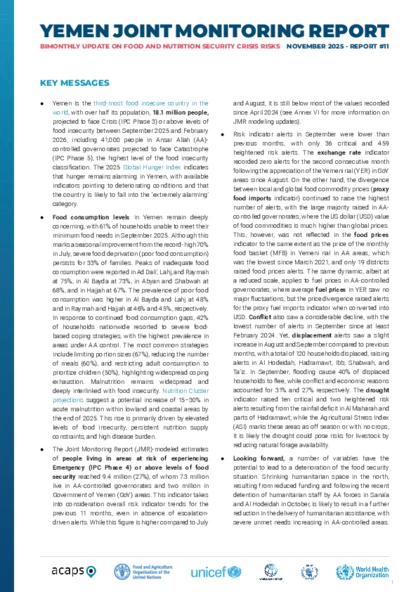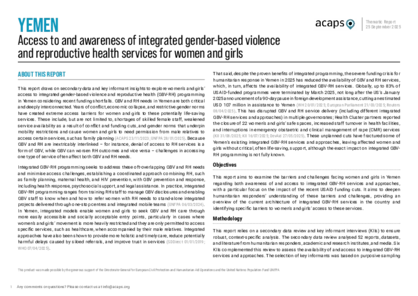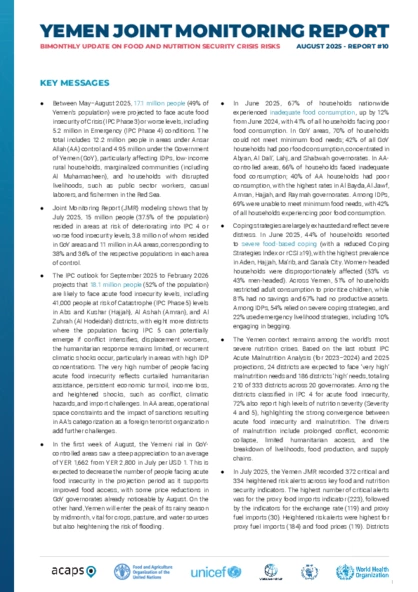Latest updates on country situation
28 October 2025
On 22 October 2025, after raiding a UN compound in Sana’a on 18 October, the de-facto authority (DFA) in the north of Yemen released 12 international staff. Just the next couple of days from 23–24 October, however, the DFA detained two other UN staff members and then raided the homes of several others, before detaining two more female WFP staff on 25 October. (AP 24/10/2025, TOI 27/10/2025)
22 October 2025
In October 2025, the de-facto authority (DFA) in the north of Yemen (also known as the Houthis) raided a UN compound in Hadda district, Sana'a, and detained around 20 employees, including five Yemeni and 15 international staff from agencies such as WFP, UNICEF, and OCHA, accusing them of espionage. DFA fighters confiscated communication equipment and temporarily occupied the compound before releasing the Yemeni staff and allowing the international personnel limited movement. This marks an escalation compared to 31 August, when at least 11 Yemeni UN staff were detained. According to the UN, at least 53 staff members remain arbitrarily detained, some since 2021, despite repeated appeals for their release. These detentions have disrupted humanitarian operations across Al Hodeidah, Sa’dah, and Sana’a, threatening aid delivery to millions of Yemenis in need of assistance. (OSESGY 18/10/2025, UNMHA 01/09/2025)
02 October 2025
Since 1 August 2025, heavy rains have triggered floods across 20 governorates in Yemen, killing at least 82 people and affecting over 450,000. The floodwaters have destroyed homes, cropland, and roads, leaving IDPs particularly affected. On the West Coast, farming losses and displacement are worsening already fragile livelihoods. (GDACS accessed 06/10/2025, ECHO 30/09/2025, IOM 18/08/2025)
02 September 2025
On 31 August 2025, the de-facto authority (DFA) in the north of Yemen (also known as the Houthis) detained at least 11 UN national staff in Sana’a and Al Hodeidah, adding to 23 other humanitarian workers already detained, some since 2021. One staff member had died in custody earlier in 2025. The detentions raise further concerns for humanitarian operations in DFA-controlled areas. (UN 01/09/2025, Reuters 31/08/2025, The Guardian 31/08/2025)
26 August 2025
Flash floods triggered by heavy rains that began in July 2025 have affected over 100,000 people in southern governorates, including Abyan, Aden, Lahj, and Ta'iz, which were the hardest hit. The flooding has damaged homes, farmland, and infrastructure, forcing secondary displacement. Affected areas already face high food insecurity, while risks of waterborne diseases and disrupted aid access are rising. (IRC 26/08/2025, SARI Global 26/08/2025, IFRC 22/08/2025)
22 July 2025
The Yemeni rial has depreciated by 34% since July 2024, reaching YER 2,890 per USD 1 on 22 July 2025 in areas under the control of the Internationally Recognized Government of Yemen. This sharp drop is further diminishing households' purchasing power. An estimated 4.95 million people in these areas face Crisis (IPC Phase 3) or Emergency (IPC Phase 4) food insecurity from May–August 2025. (FAO accessed 22/07/2025, ACAPS accessed 22/07/2025, IPC 18/07/2025)
29 June 2025
Between May–August 2025, over 17 million people in Yemen, nearly half the population, are facing high levels of acute food insecurity of Crisis (IPC Phase 3) or worse levels, including 5.2 million in Emergency (IPC Phase 4) conditions. The situation is projected to deteriorate further from September 2025 to February 2026, with the number rising to 18.1 million people (52% of the population). An estimated 41,000 people are expected to face Catastrophe (IPC Phase 5) levels in certain districts of Al Hodeidah, Amran, and Hajjah governorates given severe humanitarian aid reductions, conflict, economic decline, and below-average agricultural production caused by erratic rainfall and anticipated floods. Previously effective coping mechanisms, such as external aid and social support networks, have also become insufficient to prevent further food insecurity. IDPs, marginalised communities, and low-income households in urban and rural areas are among the most affected groups. (IPC 17/06/2025, IPC 27/06/2025, WFP 30/06/2025)
current crises
in
Yemen
These crises have been identified through the INFORM Severity Index, a tool for measuring and comparing the severity of humanitarian crises globally.
YEM003 - Floods in Yemen
Last updated 27/11/2025
Drivers
Floods
Crisis level
Country
Severity level
2.7 Medium
Access constraints
3.0
YEM001 - Complex crisis
Last updated 27/11/2025
Drivers
Conflict/ Violence
Drought/drier conditions
Political/economic crisis
Crisis level
Country
Severity level
4.6 Very High
Access constraints
5.0
YEM002 - International Displacement
Last updated 27/11/2025
Drivers
International Displacement
Crisis level
Country
Severity level
2.6 Medium
Access constraints
5.0
Analysis products
on
Yemen
25 November 2025
Yemen: bimonthly update on food and nutrition security crisis risks - issue 11
DOCUMENT / PDF / 1 MB
The JMR combines quantitative modeling and qualitative analysis to provide robust bimonthly food and nutrition security monitoring that identifies emerging food and nutrition security crisis risks.
25 September 2025
Yemen: access to and awareness of integrated GBV and reproductive health services for women and girls
DOCUMENT / PDF / 256 KB
This report draws on secondary data and key informant insights to explore women’s and girls’ access to integrated gender-based violence and reproductive health (GBV-RH) programming in Yemen considering recent funding shortfalls.
09 September 2025
Yemen: bimonthly update on food and nutrition security crisis risks - issue 10
DOCUMENT / PDF / 1 MB
The report aims to complement IPC analyses and facilitate early recognition and coordinated responses to emerging major food and nutrition security crises among humanitarian and development stakeholders.
11 June 2025
Yemen: bimonthly update on food and nutrition security crisis risks - issue 9
DOCUMENT / PDF / 1 MB
This report aims to complement IPC analyses and facilitate early recognition and coordinated responses to emerging major food and nutrition security crises among humanitarian and development stakeholders.
02 April 2025
Bimonthly update on food and nutrition security crisis risks- Issue 8
DOCUMENT / PDF / 2 MB
The JMR combines quantitative modeling and qualitative analysis to provide robust bimonthly food and nutrition security monitoring that identifies emerging food and nutrition security crisis risks.
Related datasets
Discover the
Yemen Economic Tracking Initiative
Economic trends and developments to support analysis and economic policy for Yemen
https://yemen.yeti.acaps.org/






